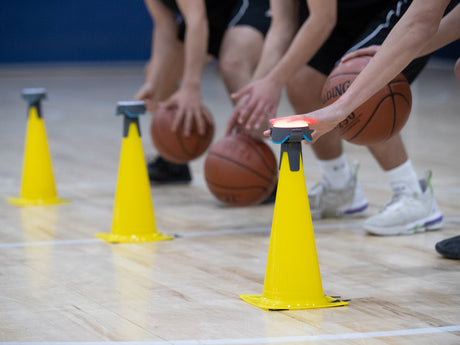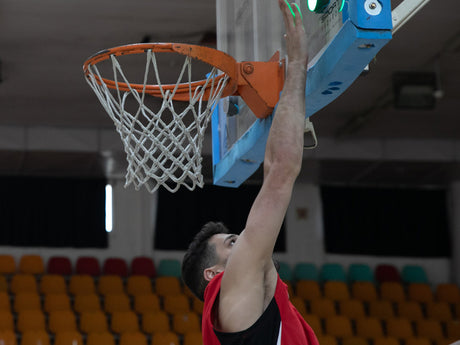Basketball is a team sport in which the players are assigned specific roles according to their strength, body shape, and abilities. There are 5 positions in basketball, but there can be as many as 7, including the sixth man and ‘the bench.’
This post will explain all basketball positions with their numbers, roles, and specific responsibilities. We’ve also highlighted the skills and attributes needed for different basketball court positions.
Different Positions in Basketball
These are the different NBA positions explained in this post and their basketball position numbers;
- Point guard (1)
- Shooting guard (2)
- Small forward (3)
- Power forward (4)
- Center (5)
These 5 players are commonly known as the ‘starting five’ because they are the first to play during a game. Often most coaches start their best 5. Some coaches have a different scheme, though, and prefer having a strong player coming in as the sixth man to add a spark into the mesh.
1. Point Guard
The point guard (PG) goes by several other names, including the one, playmaker, and the coach on the floor. Point guards are often the shortest in the team but the mightiest when it comes to ball-handling and passing skills.
The point guard position in basketball is at the top of the key. Traditionally, this player is responsible for making plays and putting the other players in the sweetest position to score, hence the name.
What Does a Point Guard Do?
The primary role of a point guard is to lead the team. He is the extension of the coach on the court. That’s to say that the point guard is responsible for organizing the other players by bringing up the ball, passing it to other teammates, and controlling the pace.
This suggests that to be a great point guard, you need to possess an excellent basketball IQ. This is important for evaluating and understanding each of your team player’s capabilities and strengths. Being smart also helps in reading the opposing team’s game style to determine the specific play your team needs to run.
While the PGs are mainly responsible for leading the offense, they also have man-to-man and zone defensive responsibilities. In man-to-man defense, the 2 point guards from the opposing teams are often matched. In this case, you’re required to stop the other PG from shooting, passing, or driving towards the basket.
In a zone defense, the point guard is responsible for guarding the top of the paint. They should prevent players from the other team from penetrating or making a successful shot from this area.
Skills Required to Play Point Guard
- You need to be smart as you’ll be calling out plays, setting up the offense, and controlling the pace.
- The PG is responsible for tracking back and forth the floor while bringing up the ball. Hence, speed and quickness are paramount.
- Point guards need to be great passers to distribute the ball accurately across the court while creating scoring opportunities.
- Excellent ball handling and dribbling skills to beat the opposing team’s point guard and players.
2. Shooting Guard
The shooting guard is also commonly known as the two or two off-guard and is often slightly taller than the point guard.
In the past, the shooting guard was required to be extremely good in shooting, hence the name shooting guard. This is still the number 1 requirement today. But modern basketball also demands an all-round shooting guard who can not only shoot but rebound and put up a solid defense.
Shooting Guard Position Roles in Basketball
Shooting guards don’t have as many responsibilities as point guards. But whatever they do is every bit vital for the team’s success. The primary responsibility of a shooting guard is to shoot the ball and score.
A shooting guard’s general description includes;
- Hitting open shots
- Hitting shots off-dribble
- Making shots off the break
- Hitting shots off the end of the floor
- Making great shot fakes
What’s clear with most of the phenomenal shooting guards in NBA history (think of Michael Jordan, Dwayne Wade, and Kobe Bryant) is the ability to shoot from almost anywhere on the floor. This versatility is what makes them the ‘silent assassins’ of the team.
But scoring isn’t all that a shooting guard does. You also need to be an excellent dribbler to offer backup to the point guard in the full-court press. Defensively, the SG should be good at stopping the opposing opponent guard from shooting and preventing other players from shooting off screens.
Skills Required to Play Shooting Guard
- As the primary role, a great shooting guard should be good at making pure jump shots and 3-pointers.
- iShooting guards should be excellent ball handlers to offer backup to point guards in advancing the ball up the court.
- Versatile defending skills to cover the point guard and defend against the opposing shooting guard.
- Ability to move around the court without the ball and work off screens to get yourself open for treys and midrange shots.
3. Small Forward
Also known as the three, the small forward is anything but small. Typically, small forwards are slightly taller and preferably physically stronger than a shooting guard but shorter than the Power Forward and Center.
In the NBA, small forwards are in the range of 6' 6" to 6' 10". In the WNBA, the height requirement is in the field of 6' 0" to 6' 2".
Small forwards have a pivotal role in modern basketball. While their basketball roles are pretty similar to those of the SG's, small forwards need to be highly versatile. These are athletic players who can excellently score from the outside and inside, rebound, and defend both outside and inside.
Small Forward Roles in Basketball
You could consider the small forwards as the jack of all trades as they are counted on to wear several hats during the game. They are the 'Kevin Durants' and LeBron James of the team and are expected to rebound offensively and defensively.
Often the strongest all-rounder player in the team, the small forward is usually called upon to guard any of the 5 positions in basketball. For instance, if the team is falling short on the SG position, the coach may ask the SF to guard that player.
When playing offense, the small forward is expected to make 3-pointers, act as a screener, and advance towards the paint to position himself for easy layups. When playing basketball defense positions, the small has to get rebounds and guard opposing players too.
Skills Required to Play Small Forward in Basketball
- Well-rounded- one invaluable attribute to a small forward is having a unique mix of different basketball skills. While you need to be great at playing the small forward position, you'll also be guarding almost all other positions across the court. Thus, small forwards;
- Should have unbeatable ball-handling skills.
- Be able to score from outside and inside.
- Need to be great at grabbing rebounds.
- Should be quick to be able to guard different positions.
4. Power Forward
The power forward comes second to the Center in terms of height. Also known as the four, this player is often physically stronger and more aggressive than both guards and the small forward.
Today, the position of the power forward has changed tremendously. Following the gradual decline of true centers at domestic and international levels, most teams are now putting their power forwards at the space between the Center and the power forward.
Actually, owing to the speed and spacing required to play modern basketball, some teams are now taking out the basketball center position and replacing it with the power forward. This means that the PF could be playing the low post, high post (when running a typical 3-out 2-in offense play), or even the perimeter out on the wings.
Power Forward Role in Basketball
As one of the toughest players who live near the rim, the main role of a power forward is rebounding. He needs to fight for offensive rebounds to win second-chance points for the team when his teammates attempt a shot on the offensive side of the floor. Likewise, the power forward is supposed to grab rebounds on the defensive side and quickly pass the ball to the streaking point guard for easy break layups.
Secondly, owing to these players imposing physicality, the duty is theirs to defend against the mightiest and toughest players from the opposing team.
Great power forwards are not only rebounders and defenders. They also need to be an offensive threat by being able to score in multiple ways with their back to the basket.
Skills Required to Play Power Forward in Basketball
- As the primary rebounder, an effective power forward needs to have excellent rebounding skills, particularly boxing out techniques.
- Because power forwards play with their back to the basket, they should be able to make incredible post-up moves to shoot.
- Although not their primary role, power forwards who can develop open midrange and 3-point jump shots add immense strength to the team.
- Importantly, effective power forwards should also use their height and strength to block shots, especially from the little guys.
5. Center
Traditionally, the center basket position is a reserve for the tallest player. The center- or the five- plays the closest to the rim. Since ‘you can’t teach height,’ the tallest player will always be the best match for this position.
Height is a crucial asset for the centers as they are the rim protectors when playing defense. But there are other vital considerations to make, including the player’s skillset, the attributes of the other 4 players in the team, and the system that the coach intends to use.
What does a Center do in Basketball?
The center is the team’s main shot blocker. He uses his height and position to block smaller players forcing them to take difficult shots from the perimeter.
Centers play at one of the most crucial basketball offense positions and are supposed to post up.
The center also needs to be good at rebounding. Although this role is primarily for the power forward, the position of the center (right under the basket) means that there will be tons of rebounding opportunities for them.
Centers who can post up are considered a massive threat by the other team. They will often have a double team to make their movements difficult. For this reason, the center needs to have remarkable passing skills to pass the ball to open players successfully.
Skills Required to Play Center in Basketball
- Excellent shot-blocking skills.
- Should be good at offensive and defensive rebounding.
- Have incredible posting-up abilities.
- Be good at blocking shots and locking down defense.
- Should be able to set solid screens to get other players open.
- Having great passing skills to make accurate passes when they are trapped.
6. The Bench
The bench in basketball refers to all other players who don’t make the starting line but stay on the sidelines as potential substitutes. In the NBA, there is at least one substitute for every player on the court. As such, there may be as many as 5 or 7 players riding the bench.
7. Sixth Man Explained
Of the substitute players, the sixth man is the player who is often the first to join the court lineup from the bench.
The sixth man is supposed to bring a spark into the lineup. In other words, he needs to add positive energy into the game, especially if the team isn’t performing so well.
For this reason, the sixth man should be a player who clearly understands the team’s systems, just like the starting five. He also needs to be a fit player who can impact the game and enable the team to achieve the desired results.
All types of basketball players have a vital role in the success of the team. Blazepod is a handy reflex training kit that gets your players ready for their positions by challenging their strength, speed, agility, and endurance. This system is already packed with effective drills that target their offensive and defensive efficiency by adding competition to your workouts.








